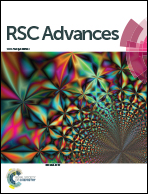Tailored products of dealloying as-sintered Al–Cu alloys in sodium hydroxide solutions†
Abstract
In this work, a two-step method of cold-press sintering–dealloying was applied to fabricate nanostructured copper/copper oxide mixtures. As-sintered AlxCu(100−x) (x = 60, 67 and 85 at%) alloy bulks that were prepared using cold-press sintering were dealloyed in 20 wt% NaOH solution under free corrosion conditions. In addition, Al67Cu33 was studied in detail to study the effects of sintering parameters on precursors and products. The XRD and SEM results suggest that a higher temperature and long duration are beneficial to promote atom diffusion and the formation of a single Al2Cu phase and tailored Cu, Cu2O and CuO with various morphologies were obtained after dealloying. During dealloying, the Al2Cu phase could be fully corroded, whereas the AlCu phase obtained from a higher sintering temperature remains after dealloying. Electrochemical studies show that the critical corrosion potential (Ecrit) of the as-sintered alloys, pure Al and pure Cu, are extremely close to the free corrosion potential (Ecorr), the intersection point of potentiodynamic cathodic and anodic polarization curves. Cyclic voltammetry results imply that the formation of oxides may be related to the reaction of dissolved oxygen and copper ions. A group of recommended parameters was identified: a pressure of 312.5 MPa, sintering temperature of 500 °C and holding time of 60 min, from which a mixture of Cu/Cu2O/CuO could be obtained which exhibits an excellent initial (10 min) degradation efficiency of 77.4% to methyl orange when exposed in an ultrasonic environment in ambient atmosphere.


 Please wait while we load your content...
Please wait while we load your content...